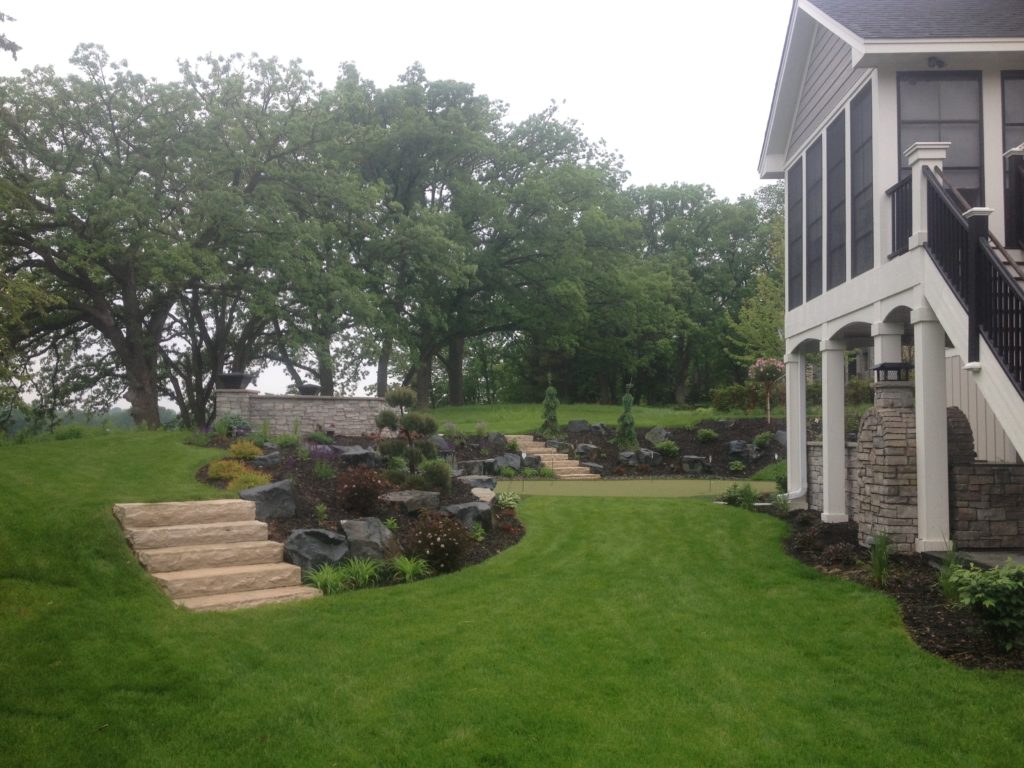Your spring lawn care objective is to encourage maximum root volume and depth in order to prepare the grass for summer heat and drought. Healthy soils, fertilizing, watering, and mowing will give you a healthy vibrant lawn.
1. Take It Easy on the Soil
Don’t be in a hurry to put your yard to work. Let the soil thaw and dry out before you start the treatment of your spring lawn.
Foot traffic on wet soil will cause problems with soil compaction. Even worse damage is caused by walking on lawns where the ground has thawed on top and is still frozen below, shearing the roots from the grass on top of the frozen ground. If you are too aggressive with raking, mowing, or aerating (any activity that exposes the ground below the turfgrass canopy to sunlight), you risk damaging fragile new growth and giving the jump to early germinating weeds. Wait until your grass is actively growing to start managing your lawn.
2. Sharpen Your Lawn Mower Blades
Early spring is a good time to check in with your lawnmower and other power tools. Sharpen the blades of your lawn mower, change the oil, spark plug and filter. A sharp blade promotes faster recovery after cutting, keeps grass looking greener, and helps prevent disease. This is a small step that will improve your lawn care regimen all season long.

3. Help the Snow Melt
Spread or remove piles of snow from shady areas if you’re lucky enough to live in an area that gets a lot of snow. This prevents the development of snow molds as the ground thaws.
4. Had Your Soil Tested Lately?
Or in the last three years at least? A soil test will tell you how much, if any, nutrients your lawn needs. It is also the only way to determine if liming is necessary or not, and how much to apply. A soil test is a valuable tool to diagnose problems with your plants in the lawn, garden, and landscape.
5. Mow Low To Remove Dead Tops
Give your lawn a good short cut to remove the dead grass tops until your lawn begins to green up. This will offer the sunlight they need to the newly emerging leaves and make them grow. Take care not to cut it too short, causing the plants’ crowns to be injured or scalped. If you’re a “grass-cycler”, this first mow of the year is OK to collect the clippings and excess dirt.
6. Core Aeration
In several ways, aerating helps your lawn: decreases soil compaction, prevents thatch, encourages new root growth and increases filtration of water, air and nutrients.
Fall is the best time to aerate cool-season grasses and in the summer, warm-season grasses should be aerated-when they are growing vigorously.
If you skipped your cool-season lawn aeration last Fall, spring is the second best time to do that. Just be sure to aerate before applying a crabgrass preventive.
After you aerate, a good time to topdress with compost is right after you apply organic matter to all soils.
Thatch Control – Aerating helps to control thatch and is less harmful to grass plants than raking strength. If your queue layer is more than 1/2 “thick, you’ll want to consider dethatching with a power rake. Again, wait until your grass grows vigorously and wait until after you rake to apply crabgrass prevention.
7. Overseed Bare Areas
Fall is the best seed time for cool grasses. But there’s a small’ opportunity window’ that you can take advantage of in the spring…
Once soil temperatures exceeds 50 ° F, grass seed can begin to germinate. Get your seeding done early enough so that the new grass has time before the summer stress cycle to develop strong roots.
When paired with aerating, monitoring works best. Seeds must find their way into the holes of aeration where they are covered, make good contact with the soil, and easily germinate. If you’ve been monitoring, skip the crabgrass control because it also operates on grass seed.
Seed warm-season grasses after the danger of frost has passed-in the early summer late spring.
8. Crabgrass Control
Prevention of crabgrass is a very significant chore in spring lawn care. Consider taking chemical weed controls off your spring lawn care list if your lawn is thick and vigorous. A dense and vigorous lawn is the best protection against invading weeds.
Crabgrass is an abundant weed. If you had crabgrass last year, prepare to see it again and consider using a pre-emergent herbicide. Such crabgrass preventatives keep weed seeds from germinating, so you’ll want to apply them before seeds germinate to get the best control. This is when the temperature of the soil exceeds 50 ° F. Most gardeners are planning to apply their Easter pre-emergence. Blooming forsythia is another good indicator-the soil temperature is 50 ° F when you see the yellow blooms.
Don’t worry if you apply preemergance late-crabgrass and other weed seeds germinate throughout the season and you’ll still get some control… better late than ever. Preemergance herbicides, together with crabgrass, will control a wide spectrum of weeds and many drugs will give you control for three to six months.
9. When Should You Fertilize and How Much?
Go simple in the spring on the fertilizer. Too much at the cost of the roots can cause a flush of growth.
Cool-season grasses-including Kentucky bluegrass, fescues and ryegrass-are expected to receive most of their annual fertilizer in the fall, which is when they benefit most. Lawns fertilized in the fall will green early and need not be fertilized until late spring. A light spring application will keep them happy during Memorial Day and give them a nice green color boost. The amount of fertilizer you add should be less than 1/2 lb Nitrogen/1000 ft2 in late spring.
Make it up with a few light applications if you missed your fall fertilizer. Wait until the grass grows (around mid-April) and apply 1/4 to 1/2 lb of nitrogen/1000ft2. Six weeks later, make another light application (Memorial Day).
Warm-season grasses benefit from the application of summer fertilizer as they grow actively. Stay until they green up to fertilize Bermudagrass, zoysia, St. Augustine, and other hot-season grasses. At least 75% of the lawn should be green. Fertilizing too early in the spring can cause a flush of growth that can damage the plants if there is a late heavy frost.
10. Wait to Water
Watering should be the last thing on your spring lawn care plan. Starting watering in the early spring is tempting, but normally there is plenty of rain to keep your lawn safe. Avoid until the weather is hot and dry.
Allowing the grass to show signs of drought stress is okay-this will actually cause the roots to expand in search of water. Waiting until the weather turns hot and dry facilitates deep digging, preparing the lawn for the summer dog days.




